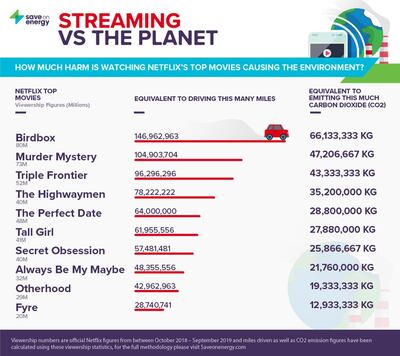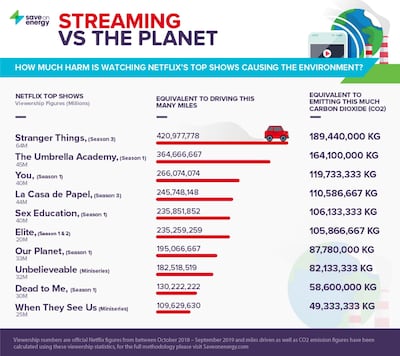As we all move to a more indoor-focused lifestyle for the foreseeable future, it seems only natural to turn to Netflix for some reprieve.
And, why not? It's a safe and relatively harmless way of getting in some light entertainment, right? Not so fast, it seems.
A new study has analysed just how much of a carbon footprint our streaming habits are leaving, and it's probably larger than you think.
Energy comparison site SaveonEnergy, which operates in the US and UK, has used official Netflix viewership figures to determine the environmental impact of streaming. Using figures for Netflix’s top shows and movies, they then compared it to the equivalent in miles driven by a car, and the amount of carbon dioxide emitted into the atmosphere.

And some of the findings might be enough to have you turning to your favourite book for some quiet time, instead.
For instance, the 80 million people who watched Netflix's most-streamed original, Birdbox, essentially drove a car 235 million kilometers, and emitted over 66 million kilograms of carbon dioxide.
For those who tuned in to season three of Stranger Things (64 million views), you contributed to 420m driving miles and the production of 304m kg of carbon dioxide.
As for the 73m streams of Murder Mystery, this translates to driving over 167m miles and 47m kg of carbon dioxide.
And so it goes on.
So how is this possible, I hear you ask, considering that streaming is essentially invisible? Well, it all comes down to the cloud.
Every innovation delivered across the internet is run from data centres, colossal buildings as big as nine hectares, situated well away from prying eyes in deserts or tundra. The statistics for their power usage are eye opening.

Some estimates predict that by 2025, data centres could be responsible for 20 per cent of global energy consumption, and bearing in mind Greenpeace’s analysis that only 20 per cent of that electricity is renewable, it represents a significant burden on the environment. And yet it’s all being driven by us, by streaming videos, using artificial intelligences and interacting with the cloud.
At the end of the day, it's not just Netflix. Many services force us to use more energy than we really need to. YouTube is frequently used to listen to music rather than watching videos, and last year, researchers at the University Of Bristol released a study suggesting that were YouTube to introduce a feature that turned off video that wasn’t being actively watched, it could reduce annual carbon emissions by an amount equivalent to 50,000 cars. The authors of the study called such things “digital waste”.
Some claim that using data centres leads to unacknowledged efficiencies in the workplace or in the home, but the biggest cloud providers, Amazon, Google and Microsoft, are under increasing pressure to take these ecological issues seriously.






